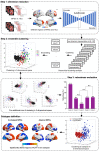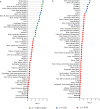Identifying and validating subtypes within major psychiatric disorders based on frontal-posterior functional imbalance via deep learning
- PMID: 33005028
- PMCID: PMC8505253
- DOI: 10.1038/s41380-020-00892-3
Identifying and validating subtypes within major psychiatric disorders based on frontal-posterior functional imbalance via deep learning
Erratum in
-
Correction: Identifying and validating subtypes within major psychiatric disorders based on frontal-posterior functional imbalance via deep learning.Mol Psychiatry. 2021 Jul;26(7):3003. doi: 10.1038/s41380-020-00938-6. Mol Psychiatry. 2021. PMID: 33203996 Free PMC article. No abstract available.
Abstract
Converging evidence increasingly implicates shared etiologic and pathophysiological characteristics among major psychiatric disorders (MPDs), such as schizophrenia (SZ), bipolar disorder (BD), and major depressive disorder (MDD). Examining the neurobiology of the psychotic-affective spectrum may greatly advance biological determination of psychiatric diagnosis, which is critical for the development of more effective treatments. In this study, ensemble clustering was developed to identify subtypes within a trans-diagnostic sample of MPDs. Whole brain amplitude of low-frequency fluctuations (ALFF) was used to extract the low-dimensional features for clustering in a total of 944 participants: 581 psychiatric patients (193 with SZ, 171 with BD, and 217 with MDD) and 363 healthy controls (HC). We identified two subtypes with differentiating patterns of functional imbalance between frontal and posterior brain regions, as compared to HC: (1) Archetypal MPDs (60% of MPDs) had increased frontal and decreased posterior ALFF, and decreased cortical thickness and white matter integrity in multiple brain regions that were associated with increased polygenic risk scores and enriched risk gene expression in brain tissues; (2) Atypical MPDs (40% of MPDs) had decreased frontal and increased posterior ALFF with no associated alterations in validity measures. Medicated Archetypal MPDs had lower symptom severity than their unmedicated counterparts; whereas medicated and unmedicated Atypical MPDs had no differences in symptom scores. Our findings suggest that frontal versus posterior functional imbalance as measured by ALFF is a novel putative trans-diagnostic biomarker differentiating subtypes of MPDs that could have implications for precision medicine.
© 2020. The Author(s).
Conflict of interest statement
The authors declare that they have no conflict of interest.
Figures





Comment in
-
Significance and stability of deep learning-based identification of subtypes within major psychiatric disorders.Mol Psychiatry. 2022 Apr;27(4):1858-1859. doi: 10.1038/s41380-022-01482-1. Epub 2022 Feb 28. Mol Psychiatry. 2022. PMID: 35228675 Free PMC article. No abstract available.
-
Response to: Significance and stability of deep learning-based identification of subtypes within major psychiatric disorders. Molecular Psychiatry (2022).Mol Psychiatry. 2022 Sep;27(9):3569-3570. doi: 10.1038/s41380-022-01613-8. Epub 2022 Jun 9. Mol Psychiatry. 2022. PMID: 35681080 Free PMC article. No abstract available.

